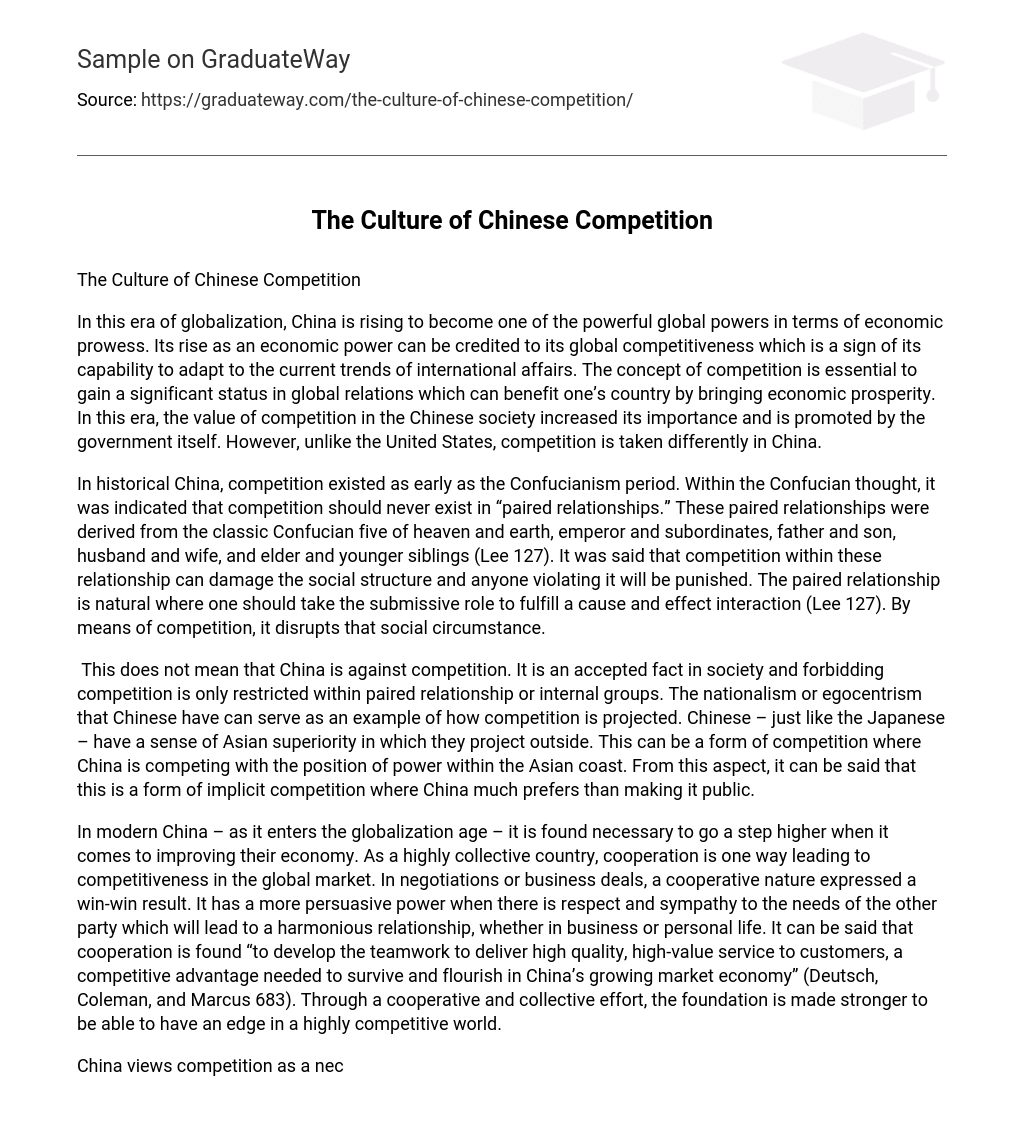In this era of globalization, China is rising to become one of the powerful global powers in terms of economic prowess. Its rise as an economic power can be credited to its global competitiveness which is a sign of its capability to adapt to the current trends of international affairs. The concept of competition is essential to gain a significant status in global relations which can benefit one’s country by bringing economic prosperity. In this era, the value of competition in the Chinese society increased its importance and is promoted by the government itself. However, unlike the United States, competition is taken differently in China.
In historical China, competition existed as early as the Confucianism period. Within the Confucian thought, it was indicated that competition should never exist in “paired relationships.” These paired relationships were derived from the classic Confucian five of heaven and earth, emperor and subordinates, father and son, husband and wife, and elder and younger siblings (Lee 127). It was said that competition within these relationship can damage the social structure and anyone violating it will be punished. The paired relationship is natural where one should take the submissive role to fulfill a cause and effect interaction (Lee 127). By means of competition, it disrupts that social circumstance.
This does not mean that China is against competition. It is an accepted fact in society and forbidding competition is only restricted within paired relationship or internal groups. The nationalism or egocentrism that Chinese have can serve as an example of how competition is projected. Chinese – just like the Japanese – have a sense of Asian superiority in which they project outside. This can be a form of competition where China is competing with the position of power within the Asian coast. From this aspect, it can be said that this is a form of implicit competition where China much prefers than making it public.
In modern China – as it enters the globalization age – it is found necessary to go a step higher when it comes to improving their economy. As a highly collective country, cooperation is one way leading to competitiveness in the global market. In negotiations or business deals, a cooperative nature expressed a win-win result. It has a more persuasive power when there is respect and sympathy to the needs of the other party which will lead to a harmonious relationship, whether in business or personal life. It can be said that cooperation is found “to develop the teamwork to deliver high quality, high-value service to customers, a competitive advantage needed to survive and flourish in China’s growing market economy” (Deutsch, Coleman, and Marcus 683). Through a cooperative and collective effort, the foundation is made stronger to be able to have an edge in a highly competitive world.
China views competition as a necessity that enables them to rise in the globalize world. As a collectivist state, they are more cooperative internally and this cooperation will reflect their competitiveness outside the borders of China. For China, both are important to maintain balance for the benefit of the state, for this is necessary to achieve more likely positive results like in negotiations or business (Spangler). However, looking at China in its internal boundaries, cooperation is more evident than competition. The fact that it is a highly collectivist state, communal thoughts and deeds are more important than being individualistic. However, it does not completely disregards competition because it is still present in the forms of sports competition, university entrances exams, etc. As the third largest economy in the world, it has been wise for China to maintain a balance between competition and cooperation because this enabled them to reach a significant progress in this time. Adapting the concept of competition may have been relatively new to its society when they were just starting to move forward with progress; but now, its people benefited a lot from its results especially when cooperation has been embedded with competition. This balance enable China to move effectively from the ruins left by its past.
Works Cited
Deutsch, Morton., Coleman, Peter., and Eric Colton Marcus. The Handbook of Conflict Resolution. United States: Wiley, 2006.
Lee Tsungnan, Charles. Cowboys and Dragons. United States: Kaplan, 2003.
Spangler, Brad. July 2003. “Competitive and Cooperative Approaches to Conflict.” Beyond Intractability. 27 April 2009 <http://www.beyondintractability.org/essay/competitive_cooperative_frames/?nid=1140>.





